Simulation Study on the Effect of Flue Gas on Flow Field and Rotor Stress in Gas Turbines
Abstract
:1. Introduction
2. Simulation Method
2.1. Computational Model
2.2. Geometric Model and Mesh Generation
2.2.1. Flow Field in a Gas Turbine
2.2.2. Gas Turbine Rotor
2.3. Boundary and Working Conditions
2.3.1. Flow Field in the Gas Turbine
2.3.2. Gas Turbine Rotor
3. Influence of the Fume Flow Rate on the Flow Field in the Gas Turbine
3.1. Influence of the Fume Flow Rate on the Flow Field Pressure in the Gas Turbine
3.2. Influence of the Fume Flow Rate on the Gas Turbine Blade Pressure
3.3. Influence of the Fume Flow Rate on the Temperature and Velocity of the Flow Field in Gas Turbine
3.4. Effect of the Fume Flow Rate on the Movement of Catalyst Particles
4. Influence of the Fume Flow Rate on Rotor Stress
4.1. No-Load Condition
4.2. Rated Flow Rate Condition
4.3. Large Flow Rate Condition
4.4. Small Flow Rate Condition
5. Conclusions
- (1)
- The variation trend of the pressure gradient in the calculation domain of the gas turbine is essentially the same under different fume flow rates. After the fume enters the stator blade through the inlet section, the pressure energy is converted into kinetic energy and impacts the rotor blade to do work. The impact will cause the uneven flow of the fume and intensify the erosion of the catalyst particles on the rotor blade.
- (2)
- With the increase of the radius, the pressure of the working face increases. The highest pressure appears near the tip with a large radius in front of the working face. With the increase of the high-temperature fume flow, the blade surface pressure increases, but the pressure change trend is basically the same.
- (3)
- The simulation results of the temperature field in the gas turbine show that the temperature and the temperature gradient change trend of the flow field in the calculation domain are consistent under different fume flow rates. The change of the fume flow has little influence on the temperature field of the entire machine. The simulation results of the velocity field reveal that the fume has an obvious acceleration process when it flows out of the rotor runner, and the high-temperature fume has low velocity before it enters the stator. After passing through the stator, the high-temperature fume expands rapidly (cooling and depressurizing), and the fume transforms its own heat energy and pressure energy into kinetic energy.
- (4)
- The distribution of the erosion location of catalyst particles on the rotor blade varies with different flow rates, but most of the erosion occurs near the leading and trailing edges of the blade and tends to occur at the large radius along the radial direction. The erosion wear of the rotor blade mainly appears near the leading and trailing edges, and the erosion wear of the leading edge is more serious than that of the trailing edge.
- (5)
- The static strength analysis of the gas turbine indicates that the maximum equivalent stress of the blade is 470, 459, 472, and 454 MPa, respectively, under the no-load, rated flow rate, large flow rate, and small flow rate conditions. The corresponding maximum stress values of the disc under those conditions are 637, 643, 644, and 640 MPa. The respective total maximum blade deformations are 0.66, 0.52, 0.65, and 0.48 mm. Under the four conditions, the maximum stress points of the blade are all located at the large fillet of the first pair of tenon teeth, and the maximum stress points of the disc are all located at the large fillet of the third pair of tenon teeth.
Author Contributions
Funding
Institutional Review Board Statement
Informed Consent Statement
Data Availability Statement
Acknowledgments
Conflicts of Interest
References
- Lu, P.; Ji, J.; Yang, L. A Review of Chinese Achievements in Developing FCC Flue Gas Turbines over the Past 30 Years. Sino-Glob. Energy 2008, 13, 8–10. [Google Scholar]
- Ji, J.; Ma, K.; Zhou, T. Innovation Creates Success—The Evolution of YL Type FCC Flue Gas Turbine over the Past 30 Years. Sino-Glob. Energy 2008, 13, 1–7. [Google Scholar]
- Lin, F.; Wang, W.; Li, M.; Li, Y. Experimental Study on the Combustion Oscillation Characteristics of Gas Turbine Combustor. J. Eng. Therm. Energy Power 2017, 32, 62–68. [Google Scholar]
- Vierling, M.; Moliere, M.; Glaser, P.; Denolle, R.; Montagne, P. Efficient Smoke Suppressant Reduces the Particulate Matter Emissions of Crude Oil Fired Gas Turbines. In Proceedings of the ASME Turbo Expo 2019: Turbomachinery Technical Conference and Exposition, Phoenix, AZ, USA, 17–21 June 2019. [Google Scholar]
- Marin, G.E.; Mendeleev, D.I.; Akhmetshin, A.R. Analysis of Changes in the Thermophysical Parameters of the Gas Turbine Unit Working Fluid Depending on the Fuel Gas Composition. In Proceedings of the 2019 International Multi-Conference on Industrial Engineering and Modern Technologies (FarEastCon), Vladivostok, Russia, 1–4 October 2019. [Google Scholar]
- Xu, W.; Zhu, K.; Wang, J.; Lin, Y.; Li, Q. Modeling and numerical analysis of the effect of blade roughness on particle deposition in a flue gas turbine. Powder Technol. 2019, 347, 59–65. [Google Scholar]
- Pan, J.; Wang, J.; Chen, S.; Zhang, X.; Liu, S. Numerical study of inlet Reynolds number in fine particles deposition processes in a flue gas turbine. Powder Technol. 2018, 339, 506–520. [Google Scholar] [CrossRef]
- Du, Y.; Zhao, H.; Yang, C.; Zhang, Y.; Hu, R. Catalyst fines behavior among FCC flue gas turbine blade rows—Erosion and fouling on blades. Chem. Eng. (China) 2012, 40, 52–55. [Google Scholar]
- Tanaka, T. Numerical Simulation of Gas-solid Two-phase Flow in a Vertical Pipe: On the Effect of Inter-particle Collision in Gas-solid Flows. Trans. ASME J. Fluids Eng. 1991, 121, 123–128. [Google Scholar]
- Gómez, L.C.; Milioli, F.E. Numerical study on the influence of various physical parameters over the gas–solid two-phase flow in the 2D riser of a circulating fluidized bed—ScienceDirect. Powder Technol. 2003, 132, 216–225. [Google Scholar] [CrossRef]
- Du, Y.; Zhao, H.; Yang, C.; Hu, R.; Zhang, Y. Catalyst fines behavior among FCC flue gas turbine blade rows—Effect of gaseous phase flow field distribution. Chem. Eng. (China) 2012, 40, 57–60. [Google Scholar]
- Yu, Y.; Wang, X.; Xie, R.; Wang, Z. Numerical Investigation on the effect of cooling steam on the erosion to the flue gas turbine impeller based on CFD. In Proceedings of the Asia-Pacific Power and Energy Engineering Conference, Chengdu, China, 28–31 March 2010. [Google Scholar]
- Wang, J.; Guo, Y.; Chen, S.; Jin, Y.; Ding, J.; Han, Z. Visualization of particle movement in flow path of flue gas turbine. CIESC J. 2018, 69, 1454–1460. [Google Scholar]
- Finnie, I.; Mcfadden, D.H. On the velocity dependence of the erosion of ductile metals by solid particles at low angles of incidence. Wear 1977, 48, 181–190. [Google Scholar] [CrossRef] [Green Version]
- Bitter, J. A study of Erosion Phenomena Part I. Wear 1963, 6, 5–21. [Google Scholar] [CrossRef]
- Bitter, J. A Study of Erosion Phenomena: Part II. Wear 1963, 6, 169–190. [Google Scholar] [CrossRef]
- Adam Khan, M.; Sundarrajan, S.; Natarajan, S.; Parameswaran, P.; Mohandas, E. Oxidation and Hot Corrosion Behavior of Nickel-Based Superalloy for Gas Turbine Applications. Mater. Manuf. Process. 2014, 29, 832–839. [Google Scholar] [CrossRef]
- Shangguan, W.; Mo, W.; Shu, H.; Yu, N.; He, P.; Zhu, F. Study on the Effect of Structure and Parameters of Engine Annular Cooling Fans on Aerodynamic Performances. Chin. Intern. Combust. Engine Eng. 2017, 38, 56–62. [Google Scholar]
- Chen, S.; Wang, J.; Jin, Y. Numerical study of movement rule of different size particles in flue gas turbine. China Powder Sci. Technol. 2018, 24, 64–68. [Google Scholar]
- Tan, H.; Wang, J.; Jin, Y. Numerical Simulation of Gas-solid Two-phase Flows in Stage Cascade of Flue Gas Turbine Used for Fcc Unit. Turbine Technol. 2012, 54, 437–441. [Google Scholar]
- Zhu, G.; Chow, T.T.; Fong, K.F.; Lee, C.K. Investigation on humidified gas turbine cycles with Maisotsenko-cycle-based air saturator. Energy Procedia 2019, 158, 5195–5200. [Google Scholar]
- Wang, J.; Lin, Y.; Xu, W.; Li, Q.; Dandekar, A. Effects of blade roughness on particle deposition in flue gas turbines. Powder Technol. 2019, 353, 426–432. [Google Scholar]
- Mayle, R.E. The Role of Laminar-Turbulent Transition in Gas Turbine Engines. Asme J. Turbomach. 1991. [CrossRef] [Green Version]
- Mashayek, F.; Pandya, R. Analytical description of particle/droplet-laden turbulent flows. Prog. Energy Combust. Sci. 2003, 29, 329–378. [Google Scholar] [CrossRef]
- Hamed, A.; Tabakoff, W.C.; Wenglarz, R.V. Erosion and Deposition in Turbomachinery. J. Propuls. Power 2006, 22, 350–360. [Google Scholar] [CrossRef] [Green Version]
- Tabakoff, W.C. Review—Turbomachinery Performance Deterioration Exposed to Solid Particulates Environment. J. Fluids Eng. 1984, 106, 125–134. [Google Scholar] [CrossRef]
- Tabakoff, W.C.; Hamed, A.; Metwally, M. Effect of Particle Size Distribution on Particle Dynamics and Blade Erosion in Axial Flow Turbines. J. Eng. Gas Turbines Power 1990, 113, 607–615. [Google Scholar] [CrossRef]
- Han, B.; Li, Y.; Jin, Y. Effect of Different Flow Rates on Gas-Solid Two-phase Flow in Fluid Catalytic Cracking Gas Turbine. China Powder Ence Technol. 2014, 20, 11–15. [Google Scholar]
- Dong, X.; Zhang, H.; Cai, X.; Wang, L. Numerical study on the erosion and abrasion behavior of the high temperature alloy material of flue gas turbine blade. J. Plast. Eng. 2014, 21, 122–127. [Google Scholar]
- Schiele, R.; Wittig, S. Gas Turbine Heat Transfer: Past and Future Challenges. J. Propuls. Power 2015, 16, 583–589. [Google Scholar] [CrossRef]
- Evans, J.; Stevens, L.M.; Bodily, C.; Kang, M.B. Prediction of Velocities and Heat Transfer Coefficients in a Rotor—Stator Cavity. In Proceedings of the ASME Turbo Expo 2004—Power for Land, Sea, and Air, Vienna, Austria, 14–17 June 2004. [Google Scholar]
- Martin, T.J.; Dulikravich, G.S. Analysis and Multidisciplinary Optimization of Internal Coolant Networks in Turbine Blades. J. Propuls. Power 2014, 18, 896–906. [Google Scholar] [CrossRef]
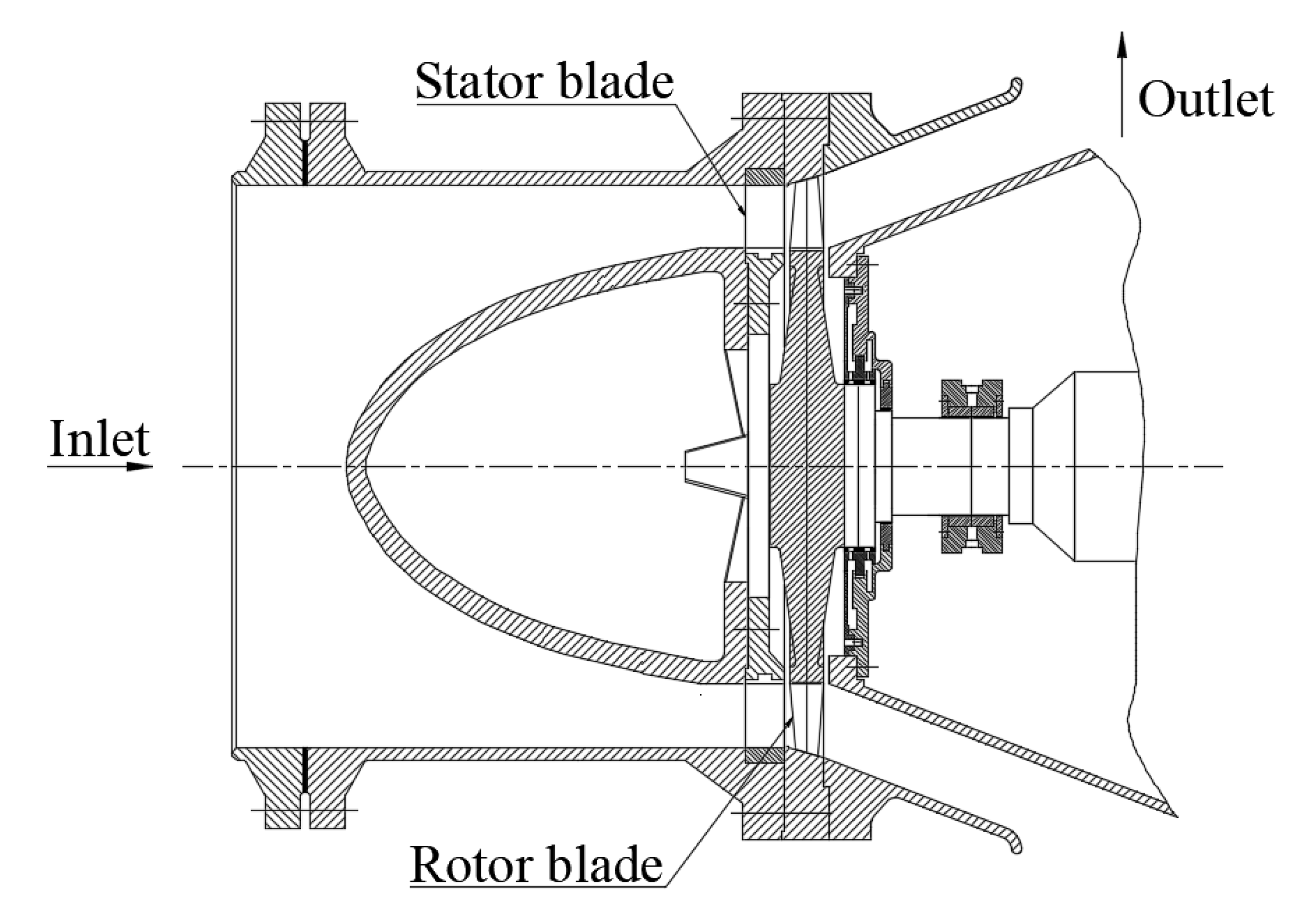

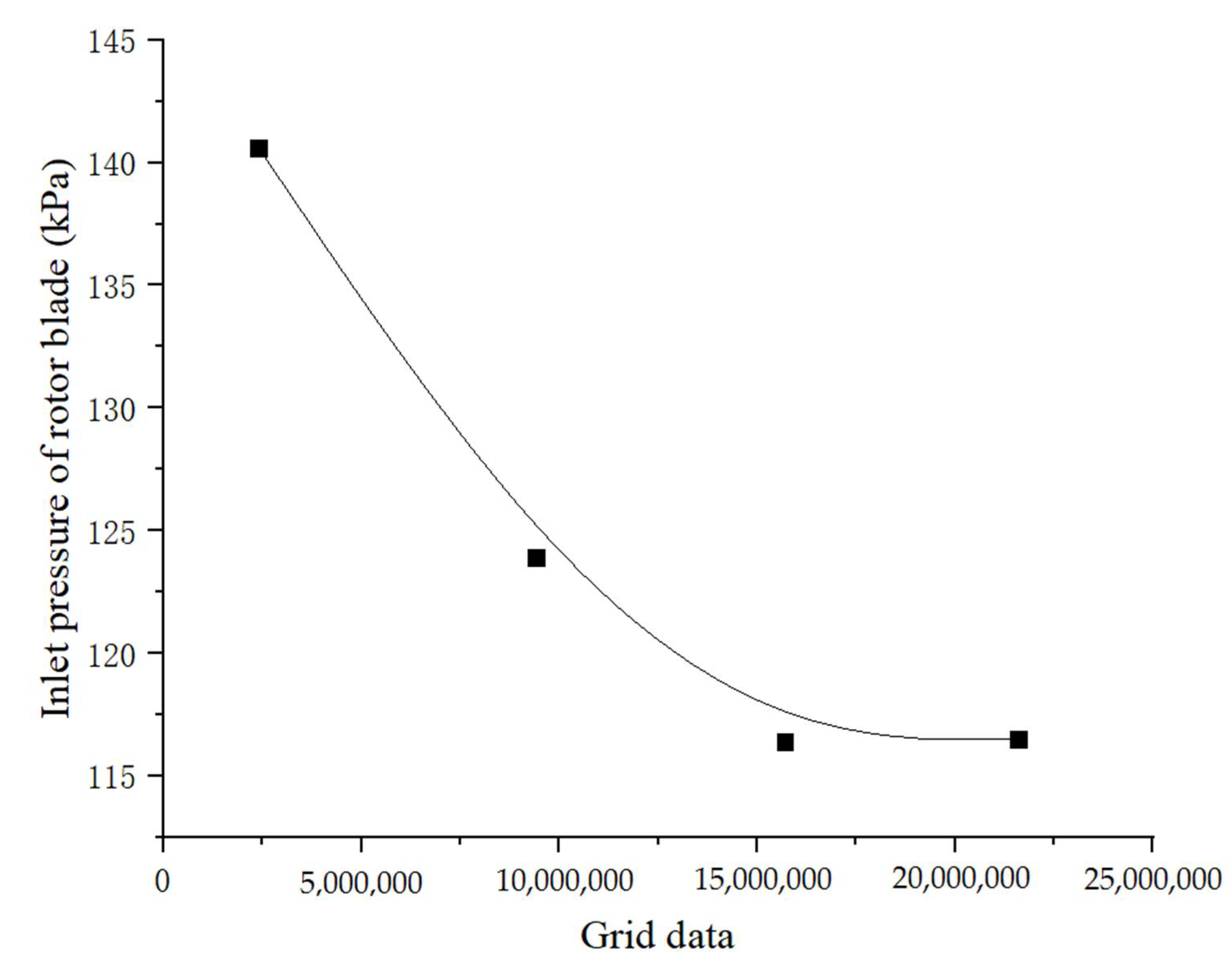
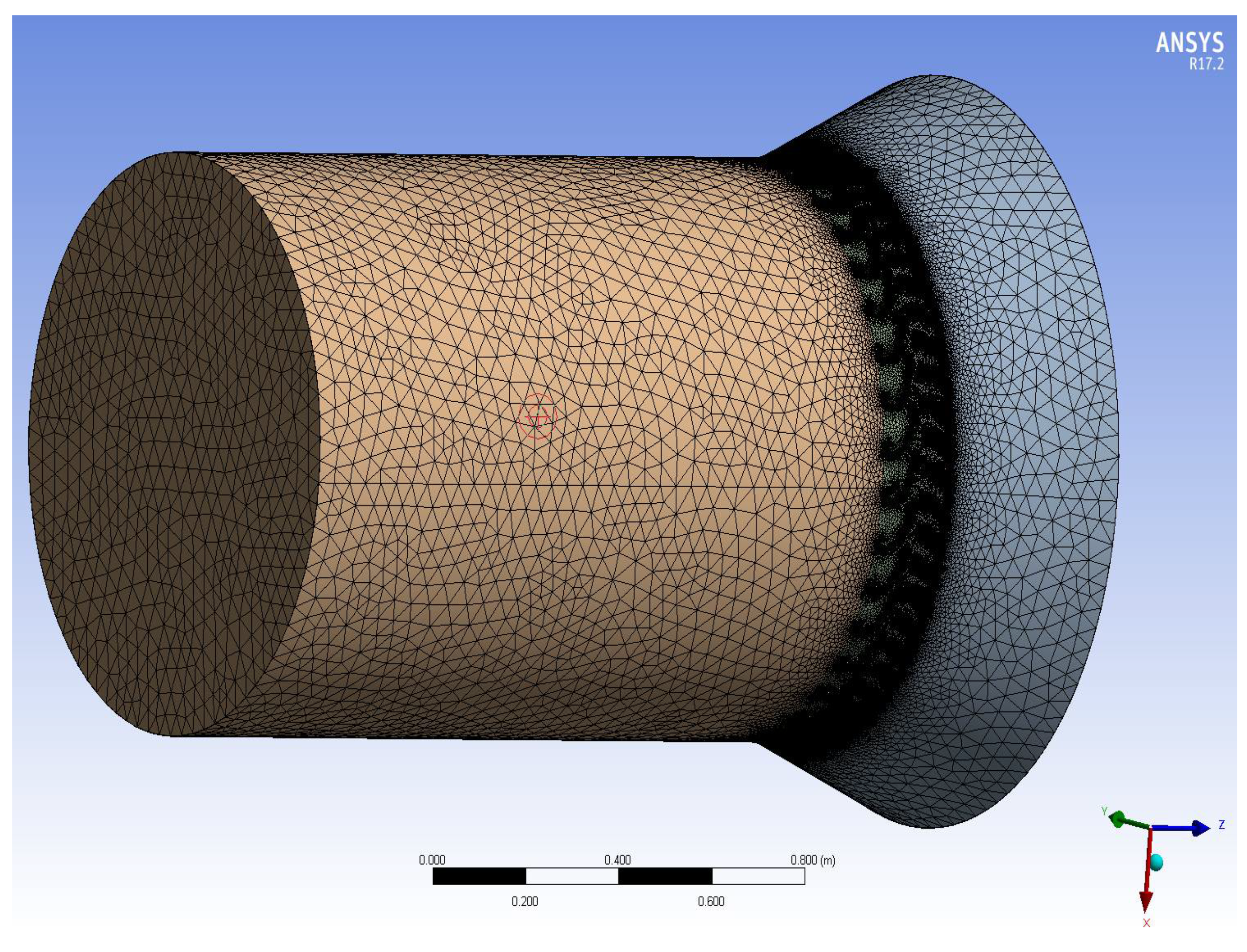


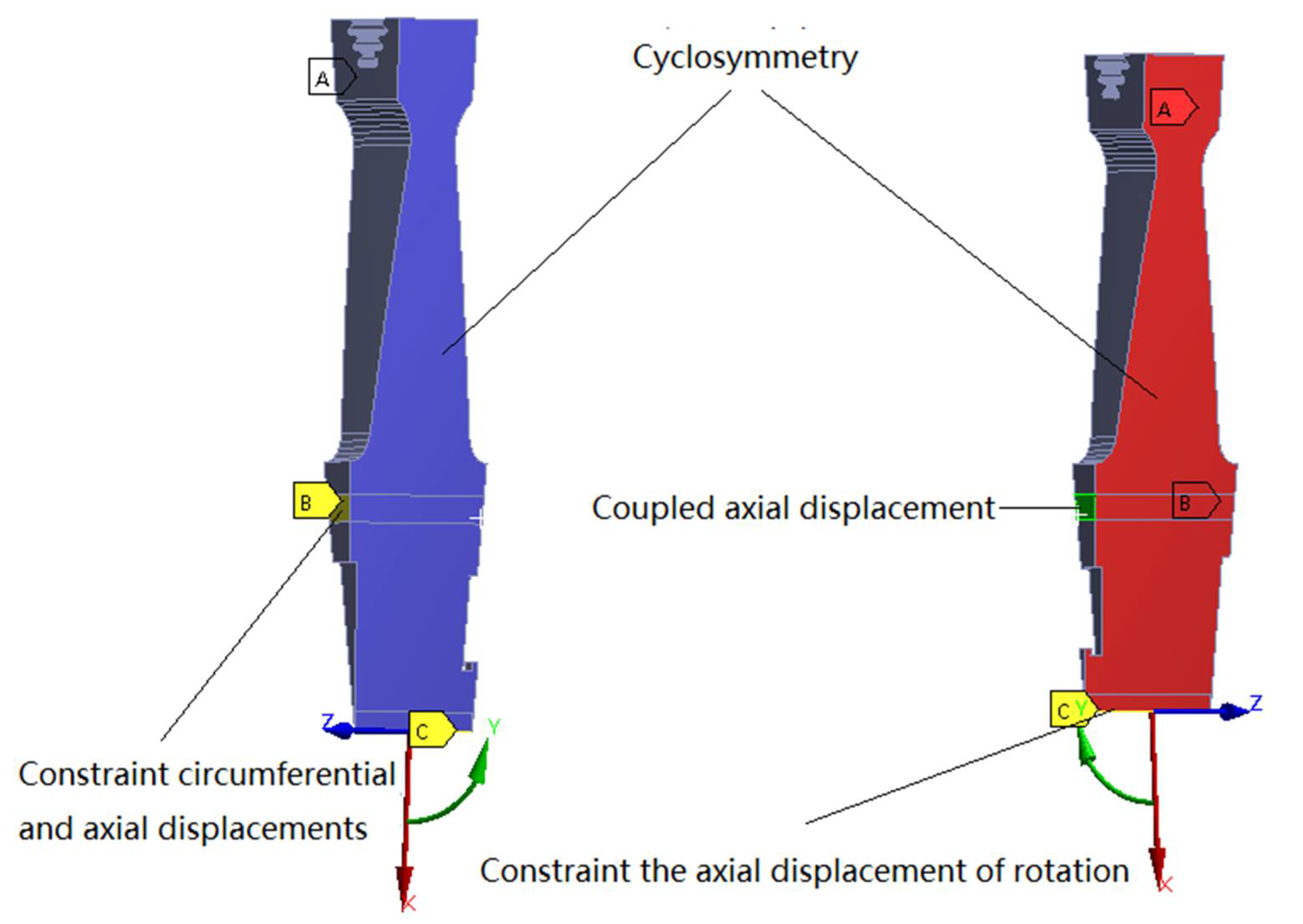
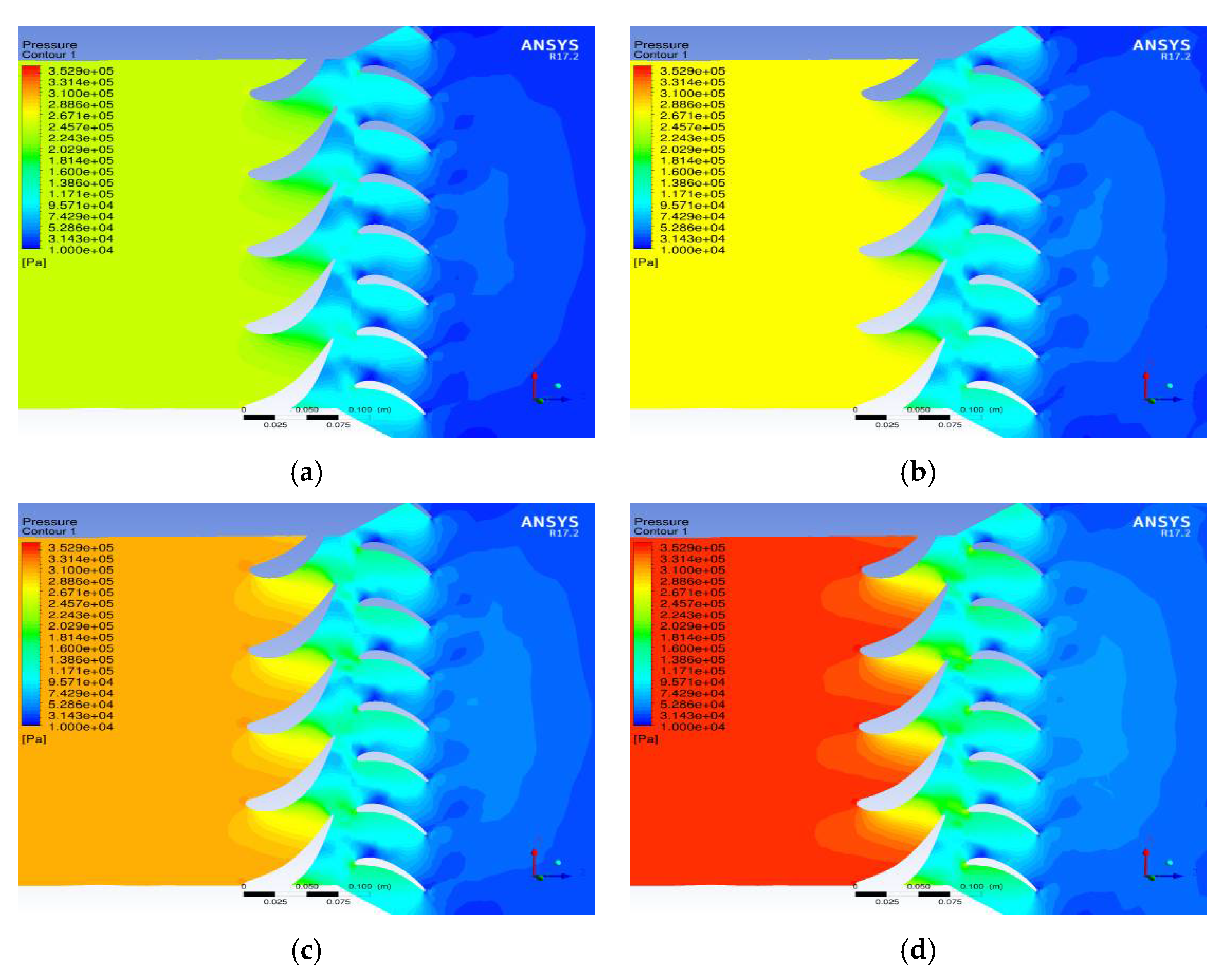
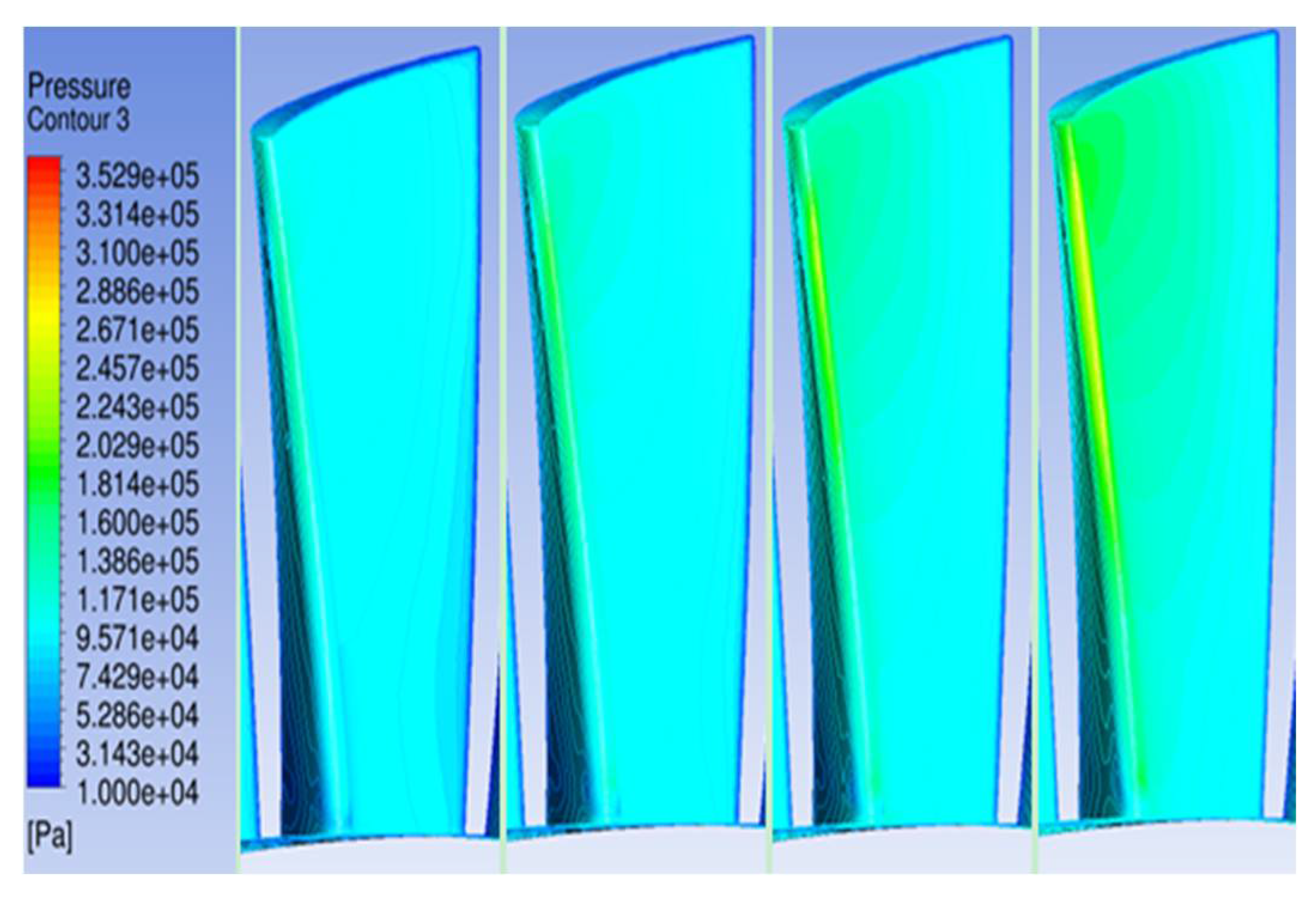


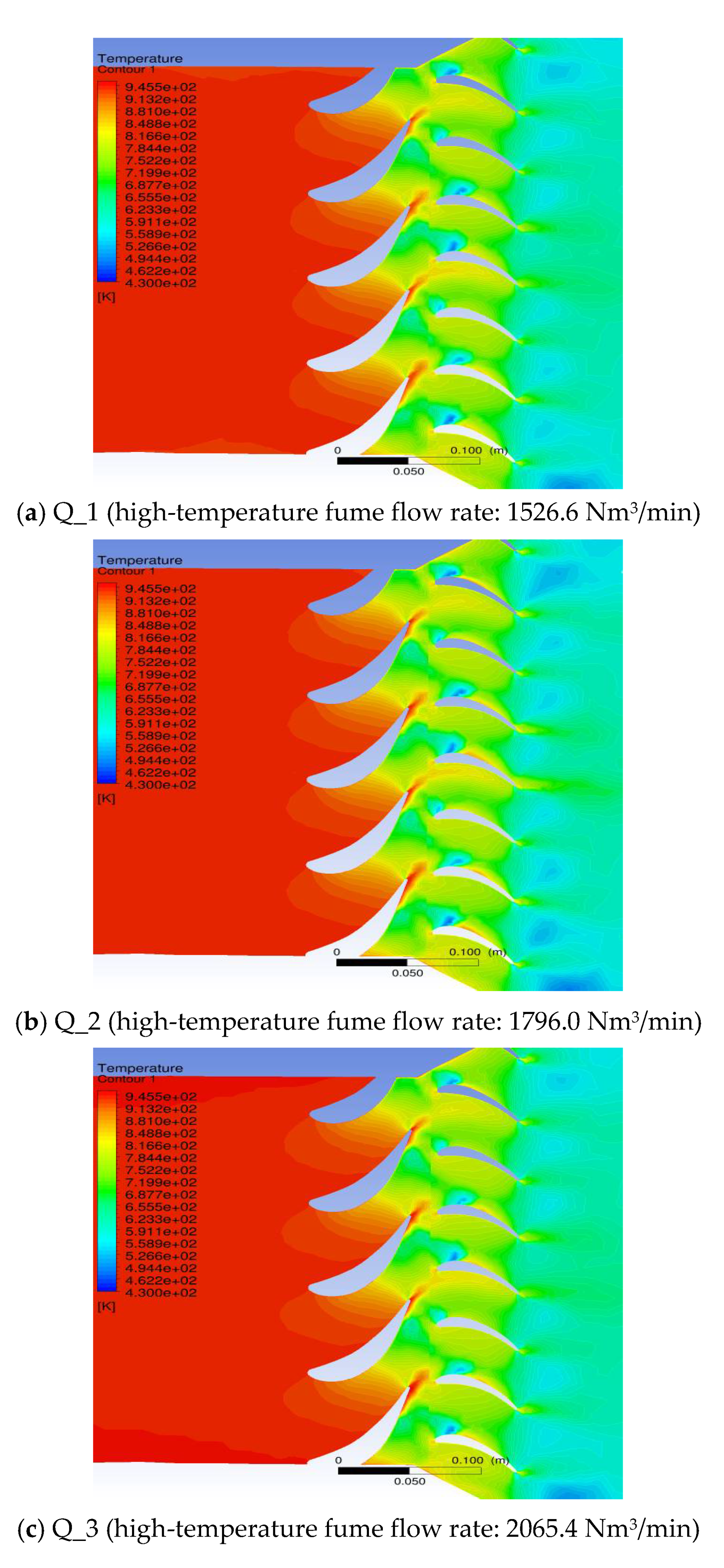




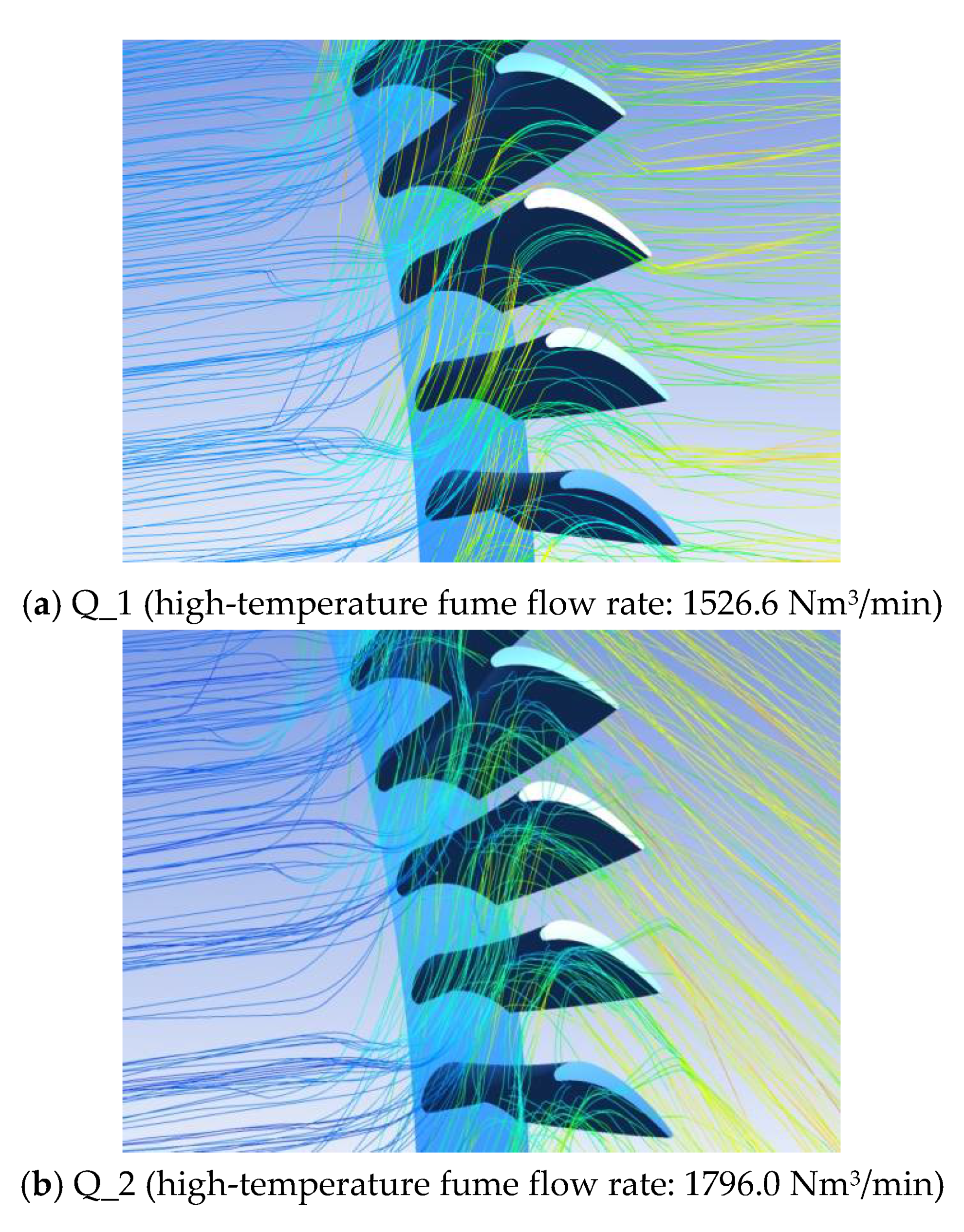
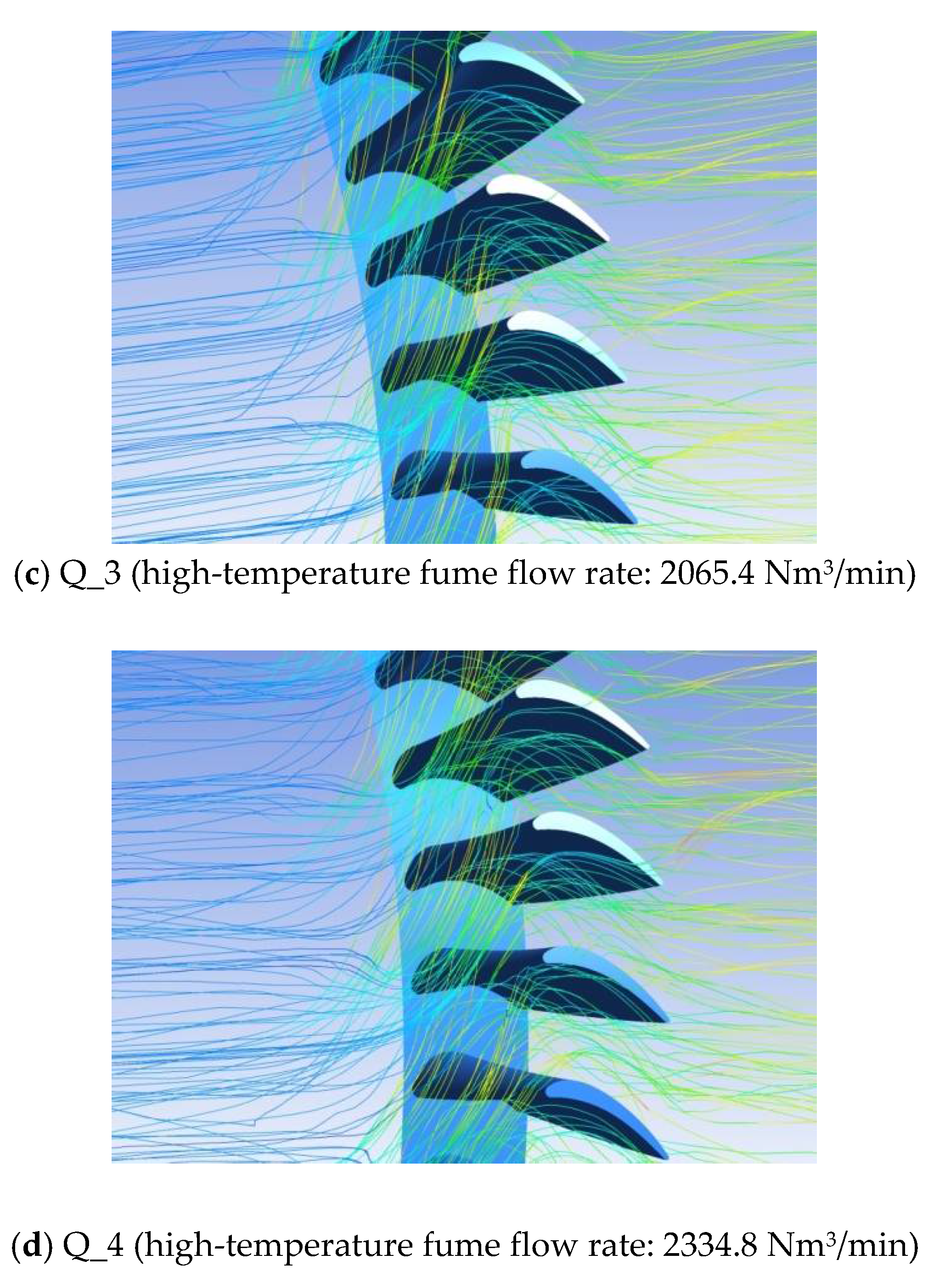
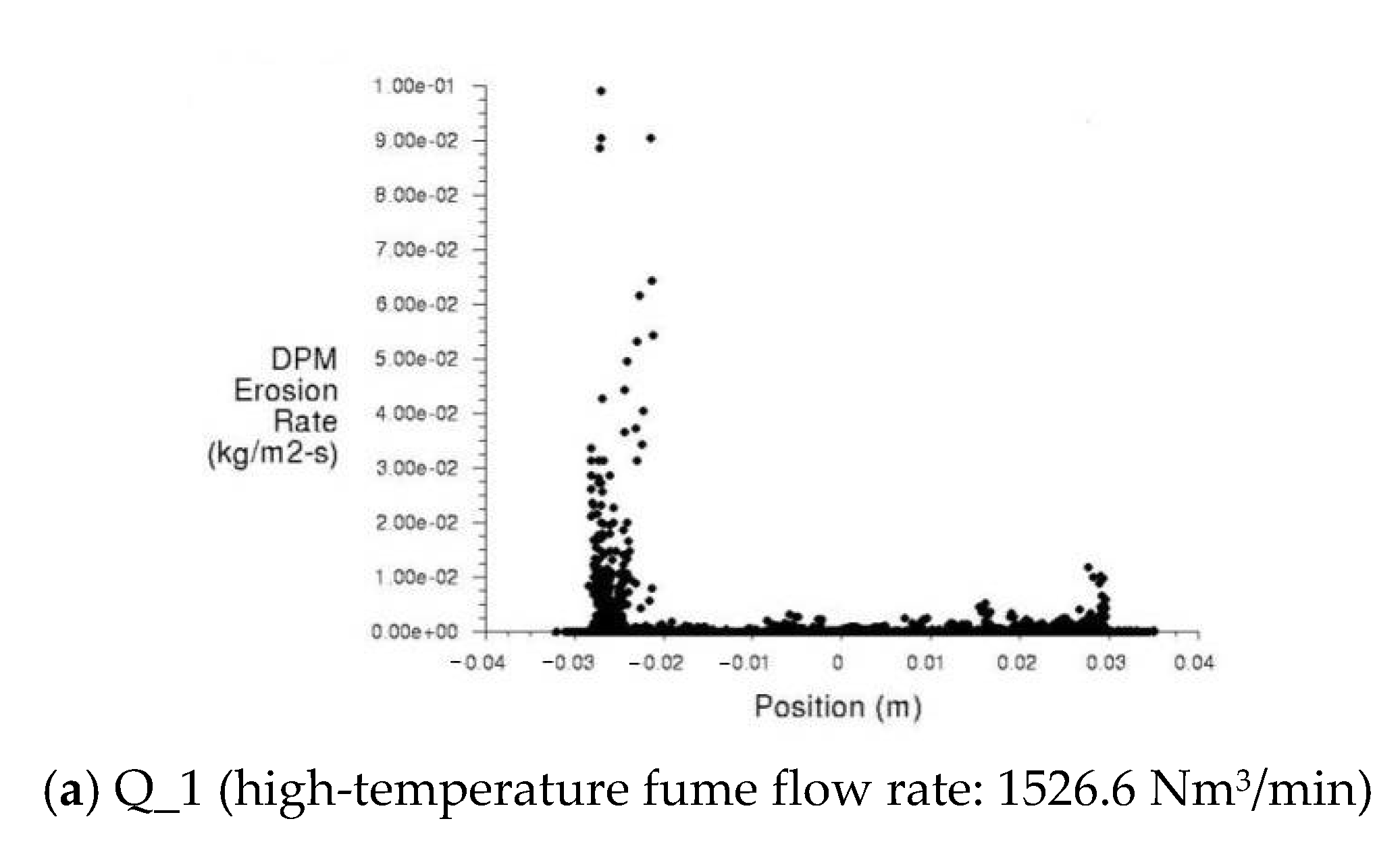
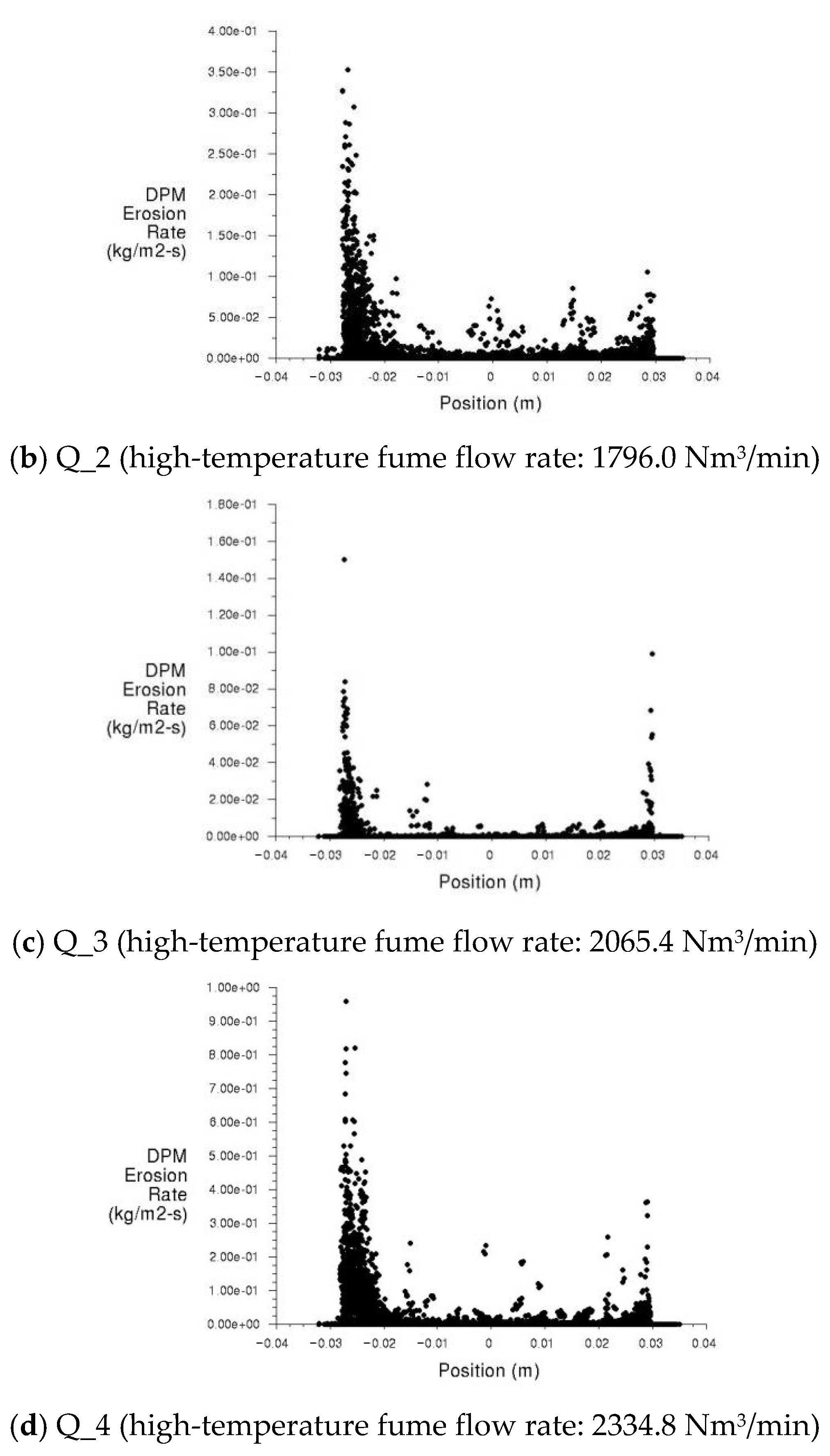

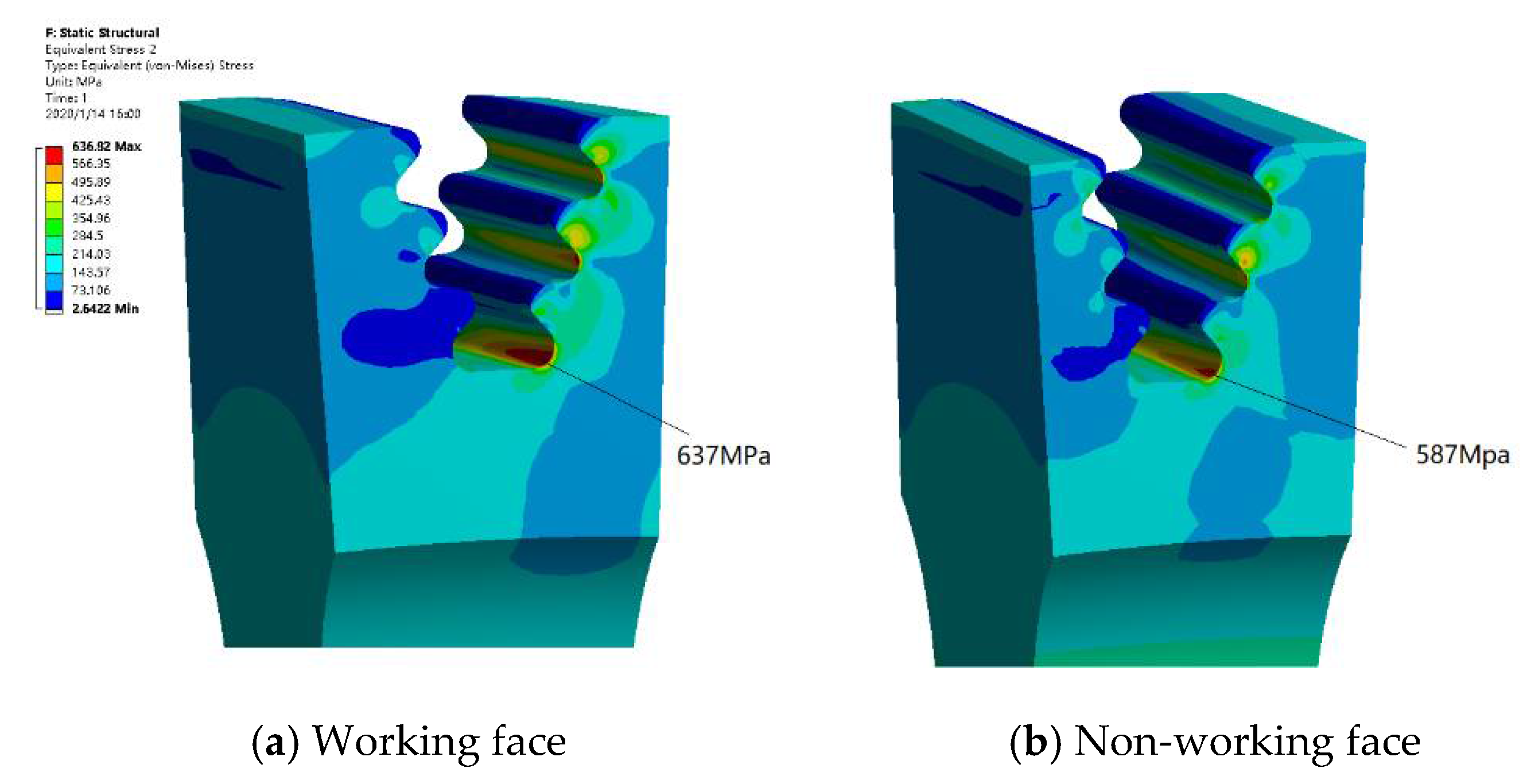

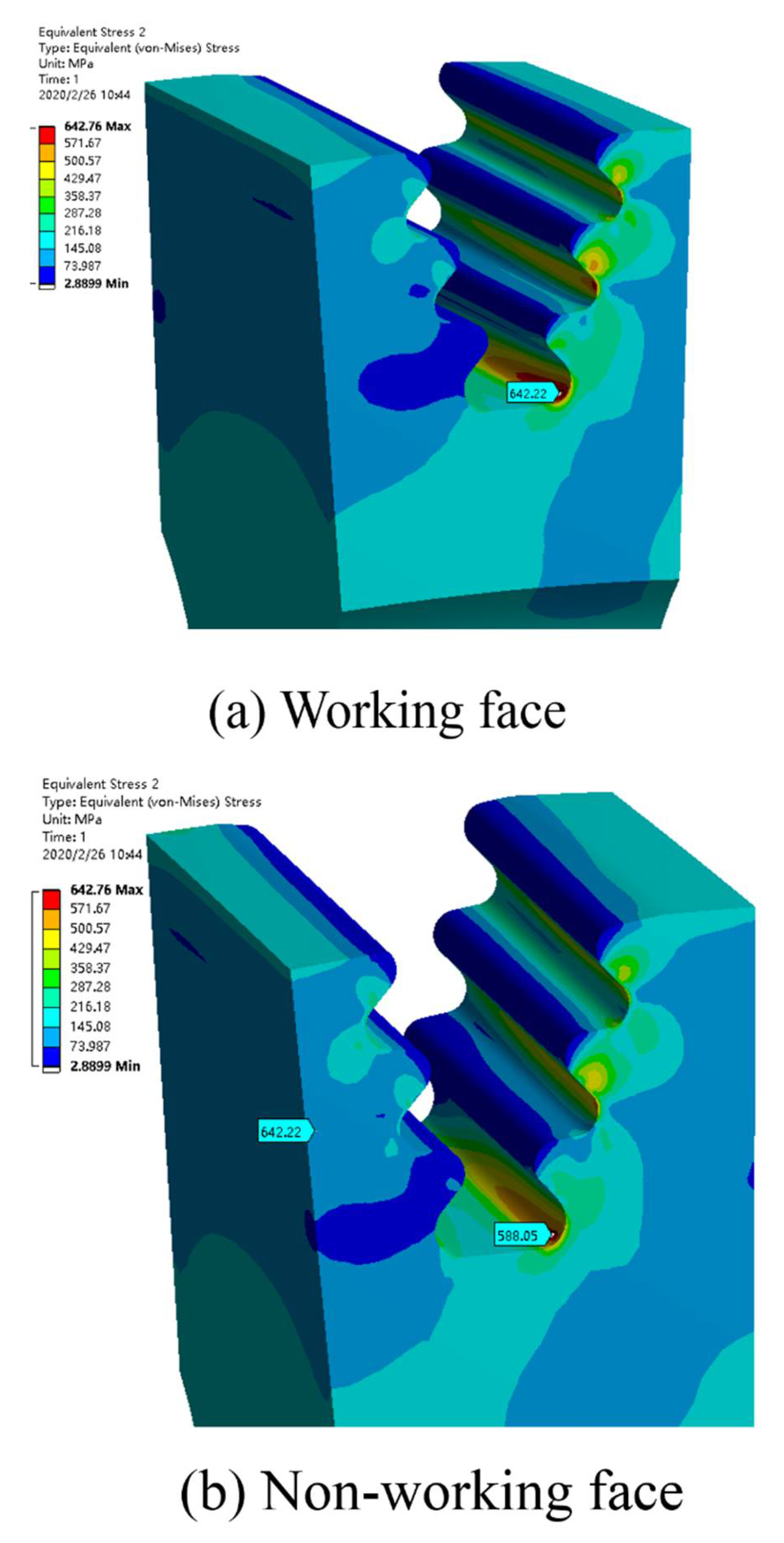



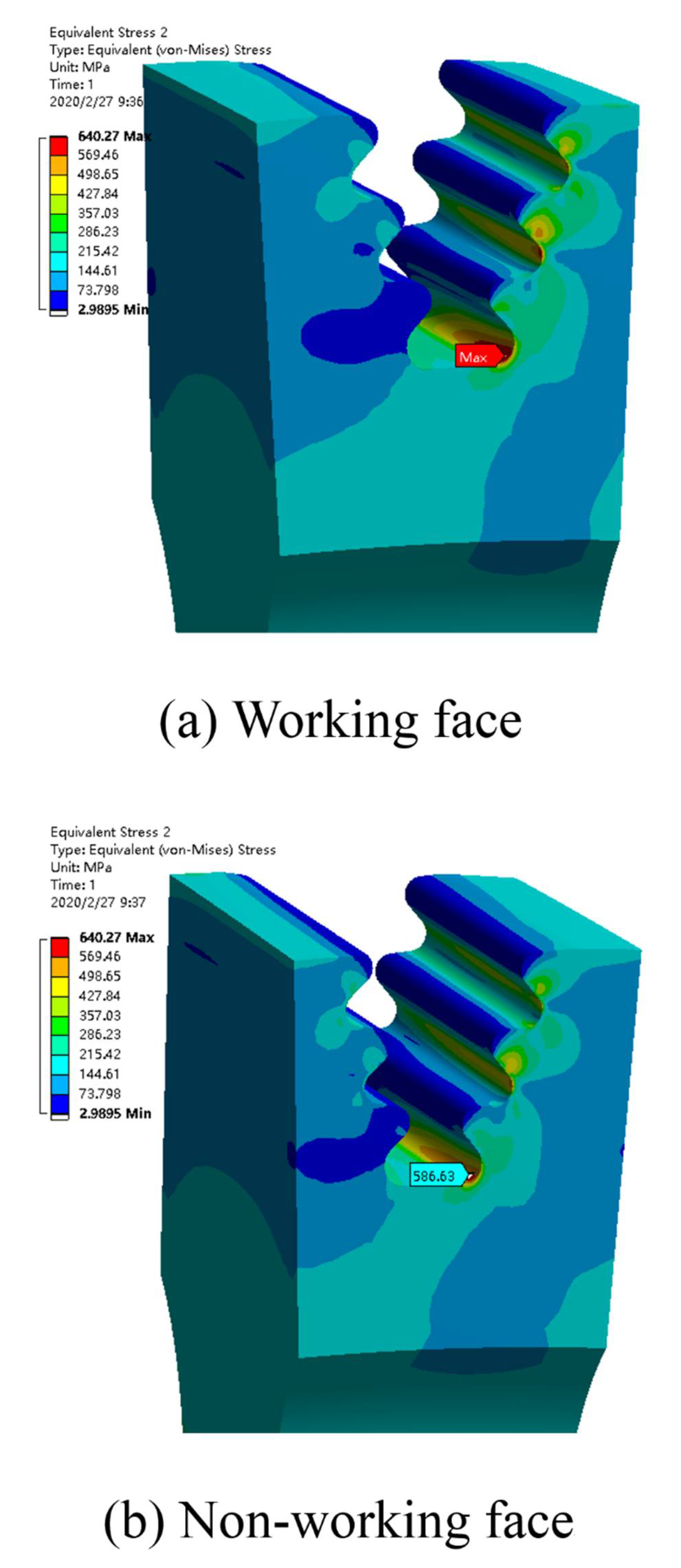
| Schemes | One | Two | Three | Four |
|---|---|---|---|---|
| Grid data | 2,400,678 | 9,424,326 | 15,701,183 | 21,595,362 |
| High Temperature Fume Flow Rate [Nm3/min] | Inlet Temperature of the High Temperature Fume [K] | Speed of the Gas Turbine [r/min] | Catalyst Particle Concentration [g/m3] | Catalyst Particle Size [m] | |
|---|---|---|---|---|---|
| Q_1 | 1526.6 | 943.0 | 6263 | 0.13 | 1.5 × 10−6 |
| Q_2 | 1796.0 | 943.0 | 6263 | 0.13 | 1.5 × 10−6 |
| Q_3 | 2065.4 | 943.0 | 6263 | 0.13 | 1.5 × 10−6 |
| Q_4 | 2334.8 | 943.0 | 6263 | 0.13 | 1.5 × 10−6 |
| Structure Name | Material Grade | Working Temperature [°C] | Density [kg/m3] | Elastic Modulus [GPa] | Poisson’s Ratio | Yield Strength |
|---|---|---|---|---|---|---|
| Blade/disc | GH864 | 670 | 8220 | 186 | 0.300 | 720 |
| Analysis Type | Inclusion Model | Load Composition | Boundary Conditions |
|---|---|---|---|
| Static strength | Blade disc | Speed: 6263 rpm aerodynamic load | 1. The circumferential and axial displacements of the upstream side face of the bolt hole region of the constrained disc; 2. The axial displacement of the downstream side face of the bolt hole region of the coupling disc; 3. The radial displacement of the rotating shaft of the constrained disc; 4. The circular symmetry condition in the disc sector. |
Publisher’s Note: MDPI stays neutral with regard to jurisdictional claims in published maps and institutional affiliations. |
© 2021 by the authors. Licensee MDPI, Basel, Switzerland. This article is an open access article distributed under the terms and conditions of the Creative Commons Attribution (CC BY) license (https://creativecommons.org/licenses/by/4.0/).
Share and Cite
Liu, G.; Sun, S.; Liang, K.; Yang, X.; An, D.; Wen, Q.; Ren, X. Simulation Study on the Effect of Flue Gas on Flow Field and Rotor Stress in Gas Turbines. Energies 2021, 14, 6135. https://doi.org/10.3390/en14196135
Liu G, Sun S, Liang K, Yang X, An D, Wen Q, Ren X. Simulation Study on the Effect of Flue Gas on Flow Field and Rotor Stress in Gas Turbines. Energies. 2021; 14(19):6135. https://doi.org/10.3390/en14196135
Chicago/Turabian StyleLiu, Guangkui, Sicong Sun, Kui Liang, Xisheng Yang, Dong An, Qi Wen, and Xiaohan Ren. 2021. "Simulation Study on the Effect of Flue Gas on Flow Field and Rotor Stress in Gas Turbines" Energies 14, no. 19: 6135. https://doi.org/10.3390/en14196135
APA StyleLiu, G., Sun, S., Liang, K., Yang, X., An, D., Wen, Q., & Ren, X. (2021). Simulation Study on the Effect of Flue Gas on Flow Field and Rotor Stress in Gas Turbines. Energies, 14(19), 6135. https://doi.org/10.3390/en14196135








